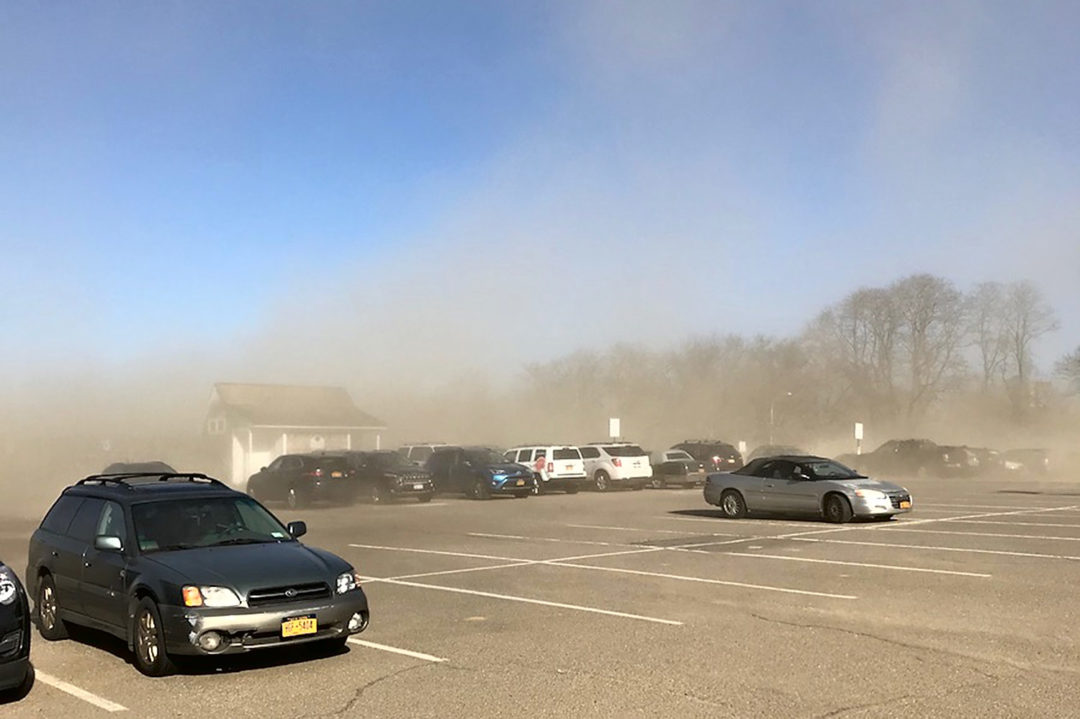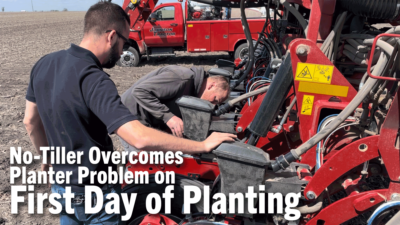Pictured Above: Dust blowing off the fields north of Long Island’s hamlet of Amagansett last January formed a thick brown cloud in the parking lot off Main Street, coating the cars parked there. East Hampton Star photo by Jack Marshall.
A few month ago in my “Frank Comments” column in the September issue of No-Till Farmer, I wrote about how the town of East Hampton on the eastern end of New York’s Long Island had proposed requiring cover crops on the area’s farmland. This came about because of dust storms that had blanketed the main street in the hamlet of Amagansett last winter.
During a mid-November meeting, members of the East Hampton town board unanimously amended the town’s zoning code to require that all farmland now be protected from wind erosion by seeding cover crops.
Wind Erosion Protection
As reported in the East Hampton Star, the move follows last winter’s conditions when fine dust blowing off dry fields covered the town and made its way indoors through the tiniest of openings. Bare soils were listed as the culprit.
The newly-passed town resolution states that soils must be reasonably protected from wind erosion with cover crops from Dec. 1– March 1.
However, if seeding and maintaining a cover crop is not possible, the new law offers several options:
1 Leaving non-harvested crops in place over the winter months.
2 Applying straw, hay, or another covering to the field.
3 Applying a nontoxic tackifier, which is described as a chemical adhesive used to keep soil, mulch or seeds in place during wind or storm conditions. (This is a botanical “glue” used in industrial hydroseeding to stabilize soils and for dust control, often promoted by suppliers as a biodegradable organic processed straw.)
4 Erosion-preventing tilling methods, which I’d assume would include no-till.
Dust Hazards
Residents in eastern Long Island had argued at town meetings last winter that the dust situation was a public health emergency. They cited how school students were kept indoors during recess, how at least one business temporarily closed due to threats to its employees’ health, along with equipment damage reported by other firms.
Farmers argued that unfavorable weather concerns during the fall of 2018 were the reasons why cover crops had not been seeded. Heavier rainfall in the Northeast left wet soil conditions, hindered fall harvest and threw off farmers’ schedules, disrupting the establishment of cover crops.
After consulting with farmers and county officials, the board last winter enacted a plan that included placing straw atop the barren fields and installing snow fencing to help keep the dirt in place.
But at a public hearing on stringent cover crop rules in June, farmers angrily pushed back against the proposed legislation that included jail time as a potential punishment for failing to seed a cover crop.
The now adopted law requires that area farmland be seeded to cover crops during the winter months, or that one of the four previously listed options be put in place. If soil is not properly protected against wind erosion, the new law calls for fines of not more than $1,500, but no jail time.
While board members refer to the law as a common-sense proposal that is good for both the farming community and residents, it’s not likely most growers would agree. But if you’re already a no-tiller and seeding cover crops, such a law should not be a burden regardless of ever-changing weather conditions.
Whether you are in favor of the new cover crop law or not, there’s no doubt that farmers across the country are going to have to figure out ways to deal with dust conditions, as ag dust concerns are already on the radar of the EPA. Thankfully, any new rules will be much less of a concern if you’re already no-tilling and seeding cover crops.








Post a comment
Report Abusive Comment